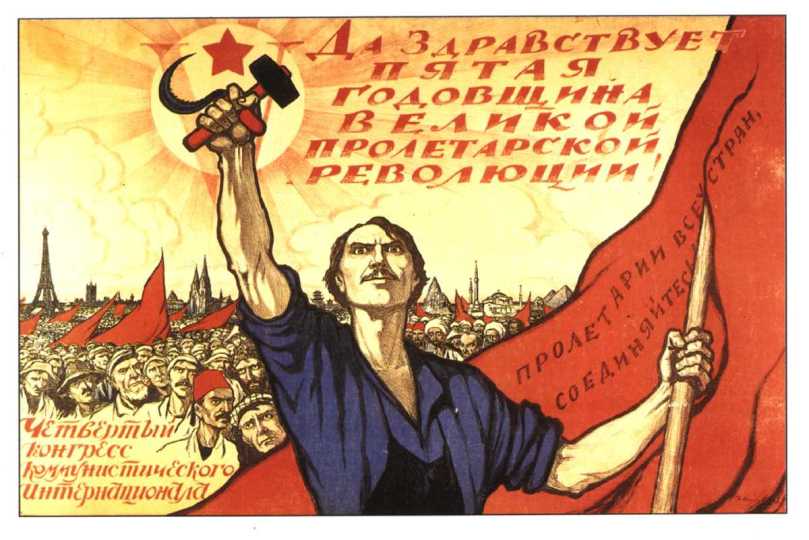A Journal of People compilation

September 1
A wave of support floods the Soviet Central Executive Committee from the Urals, the Donbas, the Central Industrial region, the Ukraine, Belorussia, Central Asia, etc. 126 local Soviets demand the Petrograd Soviet take power. The Petrograd Soviet adopts a resolution to support the Bolshevik party. The Mensheviks and SRs try to filibuster, but the resulting vote is still devastating: 279 to 115. This brings Bolshevik support to four major cities: Petrograd, Ivanovo-Voznesensk, Kronstadt, and Krasnoyarsk. The number of land seizures by the peasants increases to 958 incidents. Kerensky openly declares Russia a “Republic”, and arrests General Kornilov.
September 2
A joint session of all Soviets in Finland, a territory of Russia at that time, vote on a Soviet Government: 700 to 13. The Bolshevik party position on the right of nationalities to secede from Russia is well known, and in less than 2 months Finland would gain its independence.
September 4
Trotsky and other Bolshevik leaders are released from prison after massive public pressure. Kerensky attempts to disband the Military Revolutionary Committee; it refuses.
September 5
The Moscow Soviet announces its support for a Soviet Government (355 – 254 votes). At a Congress of Soviets of Siberia, held in Krasnoyarsk, the Soviet renews its pledge of support for the Bolshevik party.
September 6
The central committee of the RSDLP (B) nominates Lenin for election as a delegate to the Democratic Conference.
September 8
Sailors of the Baltic Fleet, through their elected organs, declare that they will not recognize the authority of the Provisional Government, nor will they execute any of its orders. On the 11th, the Central Committee of the Black Sea fleet demands: All power to the Soviets! The Kiev Soviet votes in favor of a Soviet Government (130 – 66 votes).
September 9
The Mensheviks and SRs desperately try to reassert their influence in the Soviets, and convoke a new session, with over 1,000 deputies, to try to undo the decision taken on September 1. The Soviet again votes, now 519 – 414 votes (67 abstentions), in favor of a Soviet Government.
September 11
The Petrograd Soviet of Workers’ and Soldiers’ Deputies elects Lenin a delegate to the Democratic Conference.
September 12
Lenin illegally publishes Lessons of Revolution, recounting events since the February Revolution. Lenin also finishes his most important theoretical work: The State and Revolution.
September 14
Lenin finishes his work The Impending Catastrophe and How To Combat It, where he presents a detailed outline of what the Bolsheviks will do to save the country from ruin. Lenin also sends a letter to the Central Committee in both Moscow and Petrograd, explaining “The Bolsheviks Must Assume Power”.
September 14-22
The Provisional Government convokes a “Democratic Conference”, with 1,200 delegates, in the hope of creating some kind of democratic legitimacy. Bolsheviks are in attendance, though the government aimed to arrest Lenin and Zinoviev, who did not attend. The conference votes against forming a new Coalition government. The Provisional Government, unhappy with this decision, decides to form a representative “Provisional Council” within the Conference to decide this issue, which in turn refuses a new Coalition government. Determined to get a “correct” result, a “Pre-parliament” is then created, chosen mostly by the Provisional Government, and this group approves a new Coalition government! The Bolsheviks agree to participate in the new Pre-parliament, despite the objections of Lenin, Trotsky, Stalin, and others. During this time, Lenin publishes an article “On Compromises”, explaining the Bolsheviks will seek compromises with others, so long as it does not betray their core principles.
September 15
At a meeting of the central committee of the RSDLP (B), Stalin opposes Kamenev’s demand that Lenin’s letters “The Bolsheviks must assume power” and “Marxism and insurrection” should be burned, and recommends that these should be circulated for discussion among the bigger Party organization.
September 18
Kerensky orders the dissolution of the Central Committee of the Baltic Fleet. The fleet refuses. In Tashkent, the Soviet overthrows the local government. Kerensky sends troops to take back the city, and succeeds; with many arrests and the re-introduction (when peasants were last serfs in 1861) of public flogging. Workers from 40 soviets immediately call a General Strike in response, lasting for a week.
September 21
At a meeting of the Bolshevik group at the Democratic Conference, Stalin insists on observance of Lenin’s directive to boycott the Pre-parliament.
September 23
The Bolshevik central committee approves a list of candidates for the Constituent Assembly, which includes Lenin and Stalin.
September 25
The third (and last) meeting of the Coalition government occurs, amidst staunch protests from the elected Soviets. Trotsky is elected as Chairman of the Petrograd Soviet.
September 29
The Party central committee decides to publish a list of candidates to the Constituent Assembly. Stalin is nominated for the Petrograd, Yakaterinoslav, Transcaucasian and Stavropol electoral areas.

[…] Timeline of the Great October Revolution Timeline of the Great October Revolution Timeline of the Great October Revolution Timeline of the Great […]
LikeLike